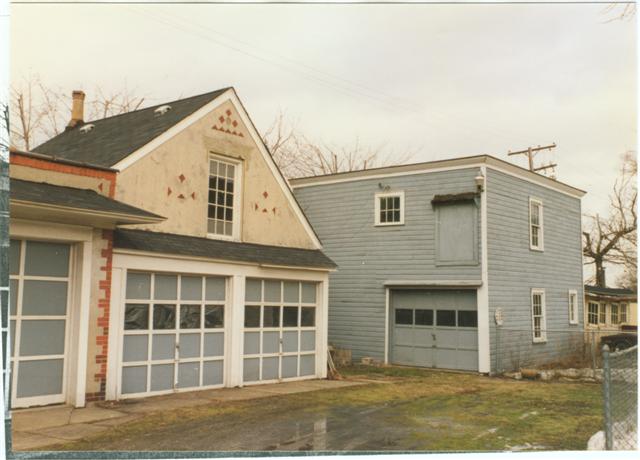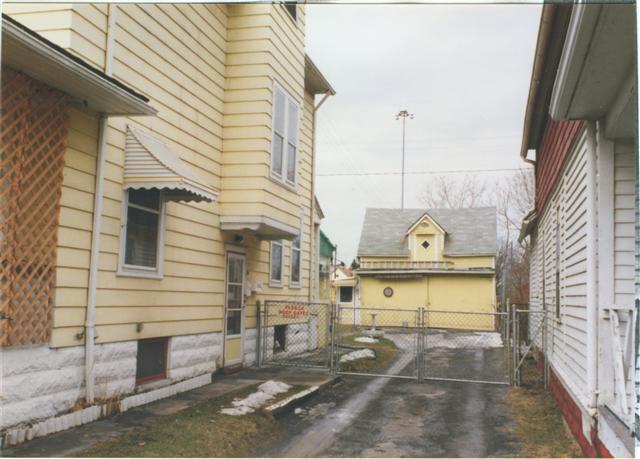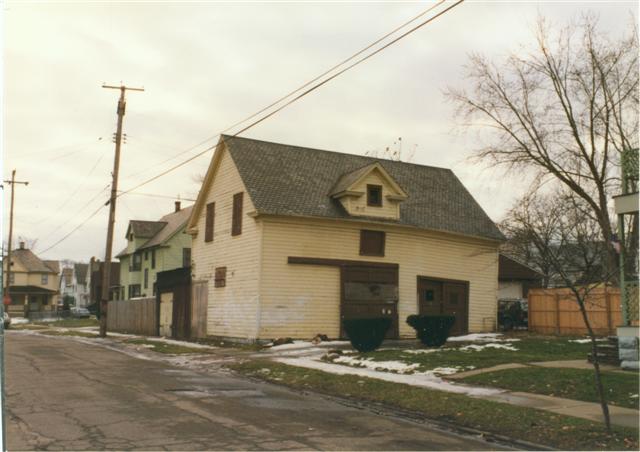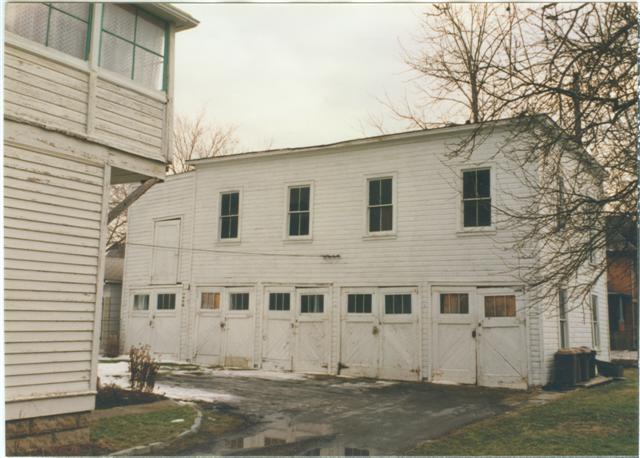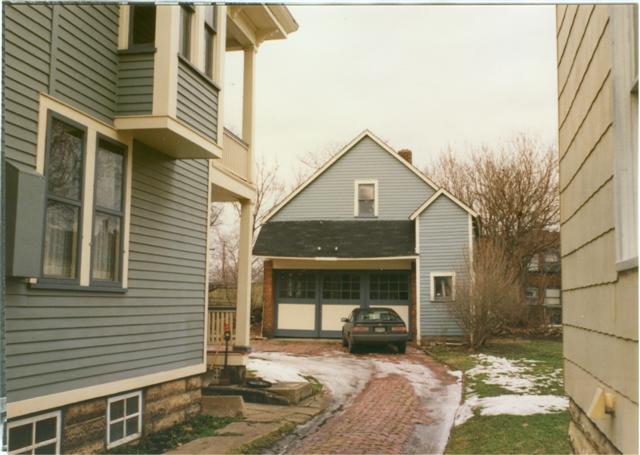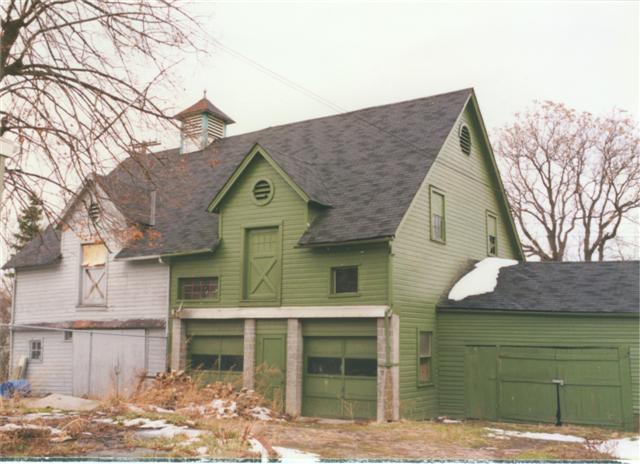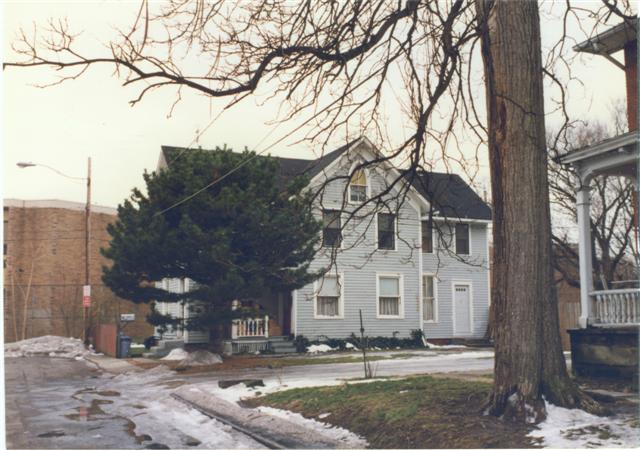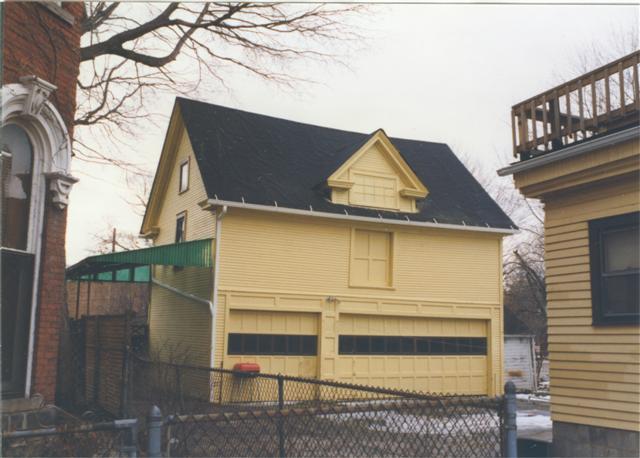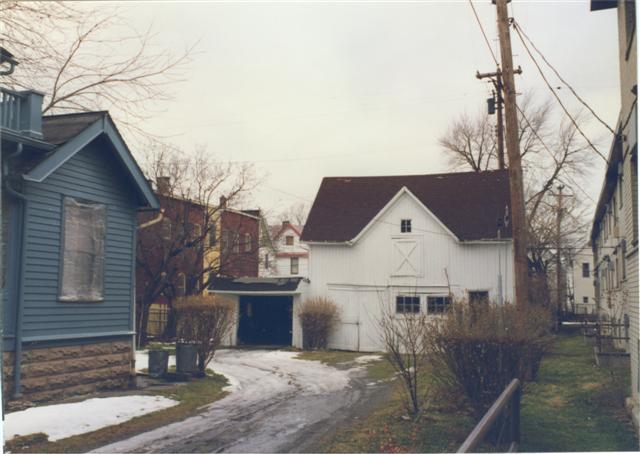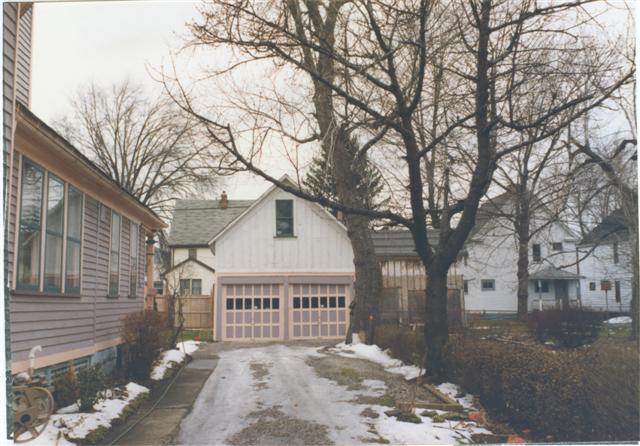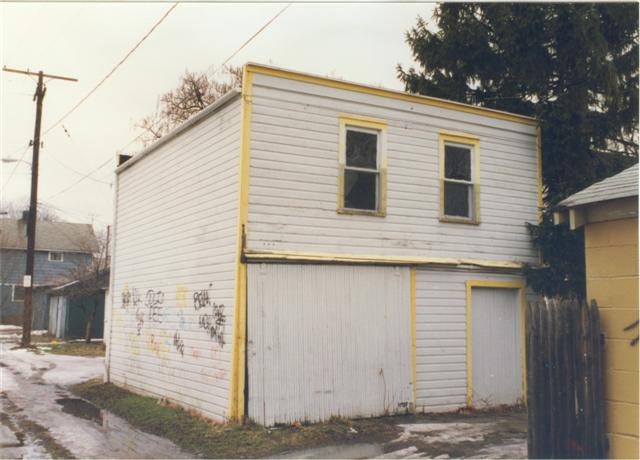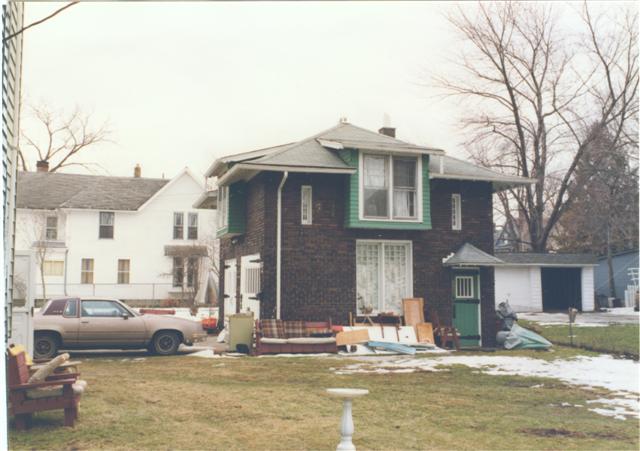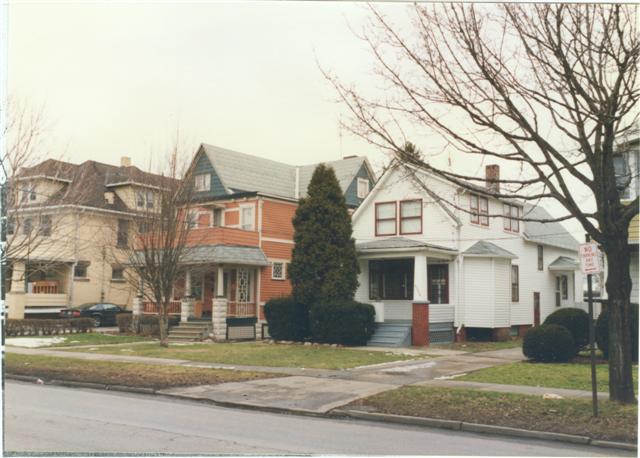|
| |||||
Carriage Barns
From Brooklyn Centre Wiki
Contents |
OLD CARRIAGE BARNS OF BROOKLYN CENTRE
- By: Steven McQuillin
- 3515 Archwood Avenue
- Cleveland, Ohio
- February 5, 1992
- 3515 Archwood Avenue
Introduction
Brooklyn Centre is a distinct geographic entity within the city of Cleveland which has managed to preserve its sense of identity through its distinctive architecture and its rather unusual and rich history. The first settlers of European ancestry arrived in this part of Brooklyn Township in the spring of 1812 and erected cabins on Pearl Road, an old Indian trail, near the sites of Denison and Mapledale. By the 1820’s Pearl Road had a stage line and was improved as a turnpike and was one of Ohio’s better roads. The township of Brooklyn was officially organized in 1818 and after that a township house was erected on Denison, of the old Newburgh Road, just east of Pearl Road. By 1830, the cluster of cabins at Pearl and Denison became known as Brooklyn Centre, the small trading center for this rural township. The Methodist church was organized in 1818 as the county’s oldest Methodist congregation and the next year a Congregational church was organized. It is now Archwood United Church of Christ.
In 1841 the Brooklyn Academy was opened as a private school for the education of area youth; in 1851 it became tax-supported. By 1852, the hamlet had become established with merchandising, manufacturing and trades. By this time the side streets of Archwood (originally Greenwood), Mapledale (Maple) and West 33rd (Liberty) were laid out and houses began lining those streets. In August 1867 this area was incorporated as Brooklyn Village, extending from Sackett Avenue on the north to Big Creek valley on the south to the Cuyahoga River on the east to West 65th Street on the west. By 1873, the lands north of Sackett, still largely undeveloped, were annexed to Cleveland. From the years 1867=1894 Brooklyn was a self—sufficient village with its own school system, fire department and constable. Houses were on fairly large lots with small gardens and carriage barns.
In 1894, this portion of Brooklyn Village was annexed to the city of Cleveland and city services such as water, paved streets, sewers and so forth were soon extended to the area. All of the streets were laid out by 1906 and most of the houses and other structures were in place by 1915. Descendants of Connecticut pioneers and early German immigrants were joined by eastern European immigrants who came to work in the nearby steel mills. The area reached its peak from the period beginning at the turn of the century and ending with the Great Depression. After World War II greater mobility and a growing trend toward suburban¬ization led to a population decline in the area. Prior to that time, demands for housing for nearby industries led to the subdivi¬sion of many fine old large houses into doubles and apartments. Rear houses were built behind main houses and old carriage barns were in some instances converted to housing.
Prior to the age of the automobile, beginning perhaps about 1915, residents of Brooklyn Centre relied heavily on the horse for transportation. Early residences were often supplemented by barns and other outbuildings. Sometimes agriculture played a role in the use of these buildings, but usually the horse and buggy were the primary occupants of these carriage barns. Carriage barns evolved as a form and seem to have continued to be constructed up to about 1915. After the turn of the century, mass transit began to be available throughout the greater Cleveland area in the form of electrified street car lines. The Cleveland Railway Company had a line running down Pearl Road in the early 1900’s, with a loop and powerhouse at Bradwell Avenue. It was later extended across the Brooklyn—Brighton Bridge. Whereas previous middle class and upper middle class residents of Brooklyn Centre required some form of conveyance, in the form of horses and wagons or carriages, new working class residents, many of them recent Eastern European immigrants employed at nearby steel mills, did not require their own transportation. They often walked fairly long distances to work and relied on streetcars for infrequent trips to downtown Cleveland. Shopping was much easier due to widespread availability of delivery wagons for all kinds of foods and services.
By about 1915, garages were beginning to be erected instead of carriage barns. Many carriage barns were then altered to accommodate automobiles. Others were kept as storage, remodeled into housing units or were demolished.
Types of Carriage Barns
About two dozen carriage barns survive in recognizable form in the heart of former Brooklyn Village: Denison, Archwood, Mapledale and Riverside. These are of a variety of architectural styles and forms. They also seem to have been constructed to serve differing purposes. The following is a list of the general types of carriage barns which were identified in a recent drive— by survey of the above principal streets of the neighborhood. Side streets were not fully investigated, and can be expected to yield other examples of these types.
A. Barns of the Brooklyn Village era, ca. 1850 — 1894
- 1. distinguishing features
- a. board-and-batten, vertical board or simple clapboard siding
- b. mortise—and—tennon framing
- c. broad and fairly steep gable roofs
- d. minimal ornamentation
- e. central upper floor door for hay loading
- 2. house styles commonly associated with
- a. Italianate
- b. Greek Revival (no surviving carriage barns related to this style of housing)
- 3. principal uses
- a. horse stalls
- b. hay and feed storage
- c. carriage storage
- d. garden equipment
B. Carriage Barns of the High—Style Era, ca. 1890 — ca. 1910
- 1. distinguishing features
- a. more elaborate siding, such as narrow clapboards, wood shingles, etc. , or even brick
- b. architectural detailing related to an American architectural style
- c. related architecturally to the house by style, form, roof pitch, detailing, etc.
- d. balloon framing
- e. gable roof, often with central dormer and hay access
- f. more elaborate forms, cantilevering, cross—shaped ground plans, etc.
- 2. house styles commonly associated with
- a. Queen Anne
- b. Colonial Revival (generally larger examples)
- 3. principal uses
- a. horse stalls, hay storage and feed storage
- b. carriage and automobile storage
- c. occasional chauffeur housing
- d. servants’ quarters on upper floors
C. Urban Carriage Barns, ca. 1900 - ca. 1915
- 1. distinguishing features
- a. simple siding such as clapboards or drop siding
- b. vernacular styling
- c. balloon framing
- d. flat roofs, often concealed behind parapets
- e. two stories, each full height
- f. simple rectangular form, often with one—story garage wing
- 2. house styles commonly associated with
- a. Colonial Revival (simpler Foursquare types)
- b. vernacular
- 3. principal uses
- a. horse stalls, hay storage and feed storage
- b. occupational—related uses
- (1) delivery trucks for delivery workers
- (2) workshops and machine shops
- (3) offices and upper floor workrooms
- c. automobile storage
Most old carriage barns have received some degree of alteration. The most common alteration is the installation of garage doors. Old carriage barns would have required perhaps a single opening in the center for the carriages, or often front and rear doors. Horse stalls would then line one or both sides of the central carriageway. The upper floor would contain hay and other feed. This would be dispensed to the horse stalls by chutes. Often, hay was delivered once or twice a year so that large well-ventilated upper floor spaces were necessary, to both avoid spoilage by storage at grade level and to facilitate horse-feeding.
In order to convert these carriage barns into garages, it would be usually necessary to remove the horse stalls and chutes, enlarge and augment existing carriage openings to permit multiple automobile storage. A later alteration would be the installation of modern overhead sectional doors.
Since loft spaces of these old carriage barns were not adaptable without considerable expense to other uses, these were generally abandoned, used only for occasional storage. Problems of maintenance and security no doubt resulted in the radical alteration of some carriage barns whereby the upper floors were simply removed and the remaining ground floor capped by a simple flat roof. This action would also enable the removal of interior supports and stairways, enabling the ground floor to be used to maximum efficiency for automobiles.
Given the circumstance in the early to mid twentieth century in this and other inner city Cleveland neighborhoods where greater industrialization and an increasing immigrant labor force were creating demands for increased housing space, it was inevitable that a number of former carriage barns would be converted to housing units. It is already well documented that many large older single family houses along Archwood, Denison and Mapledale were converted to doubles or apartments. Smaller houses were also constructed in the rear yards of some houses and in the side yards of corner houses.
Because the goal in converting an old carriage barn into a house was to make it appear as house—like as possible and-conversely to disguise its past as a somewhat lowly carriage barn, thorough alterations were generally performed, removing most traces of past uses. Two houses on Archwood have documented pasts as carriage barns, but there is little on their exterior which would suggest this. Therefore, there must be many other, undocumented examples of such conversions. Seemingly, the more high-style carriage barns which may already have had plumbing for servants’ quarters would be best suited for such conversions.
Conclusions
Carriage barns are a relatively rare and significant building form in historic Brooklyn Centre. They were constructed during a relatively brief time frame and had highly specialized uses which led to their complete obsolescence as useful building forms many years ago, with the advent of the automobile. Many have been destroyed or radically altered through removal of upper floors or complete remodeling into houses which are no longer recognizable as former carriage barns. Therefore, those carriage barns which survive take on added significance. They are distinctive links to the neighborhood’s past during an era of reliance on the horse and buggy as well as a time of stately homes and graceful carriage barns.
These surviving carriage barns also tell of the neighborhood’s past as a place of tremendous activity. In an era of delivery wagons and home enterprises, some of these carriage barns played important roles in the livelihoods of their owners. These were more practical, simple structures but are tributes to American entrepreneurship and the inventive spirit.
Where these carriage barns remain, not only is a visible reminder of the past preserved, but less visible aspects of the past are often intact. For example, old cisterns and privy sites are more likely to remain undisturbed than if the carriage barns were demolished and replaced by garages or other more intensive development. Thus, there exists on these properties the potential to learn more about our past through historic archeology techniques.
These surviving carriage barns, especially the Type B examples, are highly significant complements to their houses. They often relate to the main houses stylistically as well as in form, materials and detail. But perhaps even more importantly they proclaim the status of the builders of these houses as prosperous successful late nineteenth century and turn of the century upper middle class residents. They stand as rare survivors of a past age and add to the overall significance of their houses, lending distinction and an integrity of setting which is rare in Cleveland.
While no systematic study of carriage barns has been undertaken in Cleveland, it may be that Brooklyn Centre enjoys a special distinction in this regard. As an area which developed earlier than its surroundings, it possess a higher degree of carriage barns than surrounding later neighborhoods. And while Brooklyn Centre is an inner city neighborhood, it did not undergo the intensity of redevelopment in the early twentieth century as did Ohio City, Central, Tremont and other neighborhoods closer to the downtown and the industrial valley. In these other neighborhoods it seems likely that carriage barns had a more fragile existence, succumbing more often to the pressure for redeveloping every marketable bit of space in these dense neighborhoods. In Hough and other east side neighborhoods where the decline has been much more pronounced, it seems as though carriage barns have had a harder time surviving. University Circle has some fine carriage barns, generally more substantial than those in Brooklyn Centre, Some have been converted into restaurants and offices.
Study of carriage barns in various Cleveland neighborhoods is likely to yield much interesting information on a rare and distinctive building form which is worthy of careful preservation.
Carriage Barns In Brooklyn Centre
| Address | Street | Type | Photo Number | |
|---|---|---|---|---|
| 1. | 2904 | Riverside Avenue | C | 1 |
| 2. | 3000 | Riverside Avenue | C | 1 |
| 3. | 3310 | Riverside Avenue | B | 2 |
| 4. | 3318 | Riverside Avenue | B | |
| 5. | 3400 | Riverside Avenue | B | |
| 6. | 3408 | Riverside Avenue | B | |
| 7. | 3917 | Riverside Avenue | C | |
| 8. | 3501 | Riverside Avenue | B | 3 |
| 9. | 3319 | Riverside Avenue | C | 4 |
| 10. | 3100 | Mapledale Avenue | B | 5 |
| 11. | 3316 | Mapledale Avenue | B | |
| 12. | 3320 | Mapledale Avenue | B | |
| 13. | 2908-3000 | Archwood Avenue | A | 6 |
| 14. | West | 32nd Place | A* | 7 |
| 15. | 3107 | Archwood Avenue | B | 8 |
| 16. | 3204 | Archwood Avenue | A | 9 |
| 17. | 3332 | Archwood Avenue | A | 10 |
| 18. | 3340 | Archwood Avenue | A | 10 |
| 19. | 3607 | Archwood Avenue | C | 11 |
| 20. | 4230 | Archwood Avenue | B* | 13 |
| 21. | 3890 | West 36th Street | C | |
| 22. | 3854 | West 16th Street | B | |
| 23. | 3305 | Denison Avenue | B | 12 |
| 24. | 2200 | Denison Avenue | B | |
| 25. | 1605 | Denison Avenue | A | |
| *_ documented conversions of carriage barns into houses Source and Survey Notes | ||||
The above properties were indentified as a result of a drive—by survey of selected streets in the neighborhood on February 4, 1992 by Steven McQuillin and neighborhood historian Ruth Ketteringham. Only two—story carriage barns were included, although some lower garages may have once been barns.
Historical data was taken from the Brooklyn Centre Multiple Resource
Area National Register nomination form, prepared by Steven McQuillin.
The 1922 Cuyahoga County Plat Book was another data source. The
original was borrowed from Ms. Ketteringham for this study.
Documentary Photographs
February 1992
- 1. 2904 Riverside Avenue, at right, and 3000 Riverside Avenue, with the gable roof at left, looking northeast.
- 2. 3310 Riverside Avenue, looking north; this barn has horizontal drop siding and a central hay loft gable with hoist.
- 3. 3501 Riverside Avenue, at the southwest corner of W. 35th St., looking southwest; the northwest corner of this apparently unaltered barn has a noticeable sag.
- 4. 3319 Riverside Avenue, looking southeast; this must have had some industrial or occupational use because of its large size
- 5. 3100 Mapledale Avenue, looking north; the west wall is yellow brick; at right is a wing which seems to house a stairway to the loft level.
- 6. 2908-3000 Archwood Avenue, looking northwest; this is the largest surviving barn in the district and is today split between two lots; it was said to have once housed a World War I era airplane
- 7. West 32nd Place, looking south; this large old barn is now a two-family house and was apparently much remodeled; note the interesting old lancet window in the side gable; it was built for a large and elaborate brick Italianate side hallway house which still stands in front of here.
- 8. 3107 Archwood Avenue, looking southwest; this is a well-preserved high—style carriage barn; the house in front is a large Colonial Revival style house dating from around 1905.
- 9. 3204 Archwood Avenue, looking north; this is an apparently very old vertical-board-and-batten barn, seemingly little altered.
- 10. 3340 Archwood Avenue, at left and 3332 Archwood Avenue, at right; looking north; both of these are old simple structures and relate to Italianate style and vernacular houses.
- 11. 3607 Archwood Avenue, looking northwest; this simple barn faces onto an alley and stands behind a simple Colonial Revival style Foursquare house dating from about 1910.
- 12. 3305 Denison Avenue, looking south; this is the most elaborate carriage barn in the neighborhood and its upper floor is used as an apartment today; set at the far corner of the lot, it is visible from both Denison and W. 33rd; its house is a large high-style Colonial Revival from about 1910, now heavily altered.
- 13. 4230 Archwood Avenue (white house at right), looking northwest; this was originally a carriage barn for the house at 4234 Archwood Avenue (red house at left) and was greatly remodeled into its present form; this was documented as the home of the Louise Higler family; there are probably many more carriage barns in Brooklyn Centre which have been similarly remodeled so that it is difficult to guess that they were once barns.
Notes
Permission to use this report on the Brooklyn Centre Wiki was granted in August 2009 by the author, Steve McQuillin.
Help support this website by visiting some of the Ads provided by Google.

